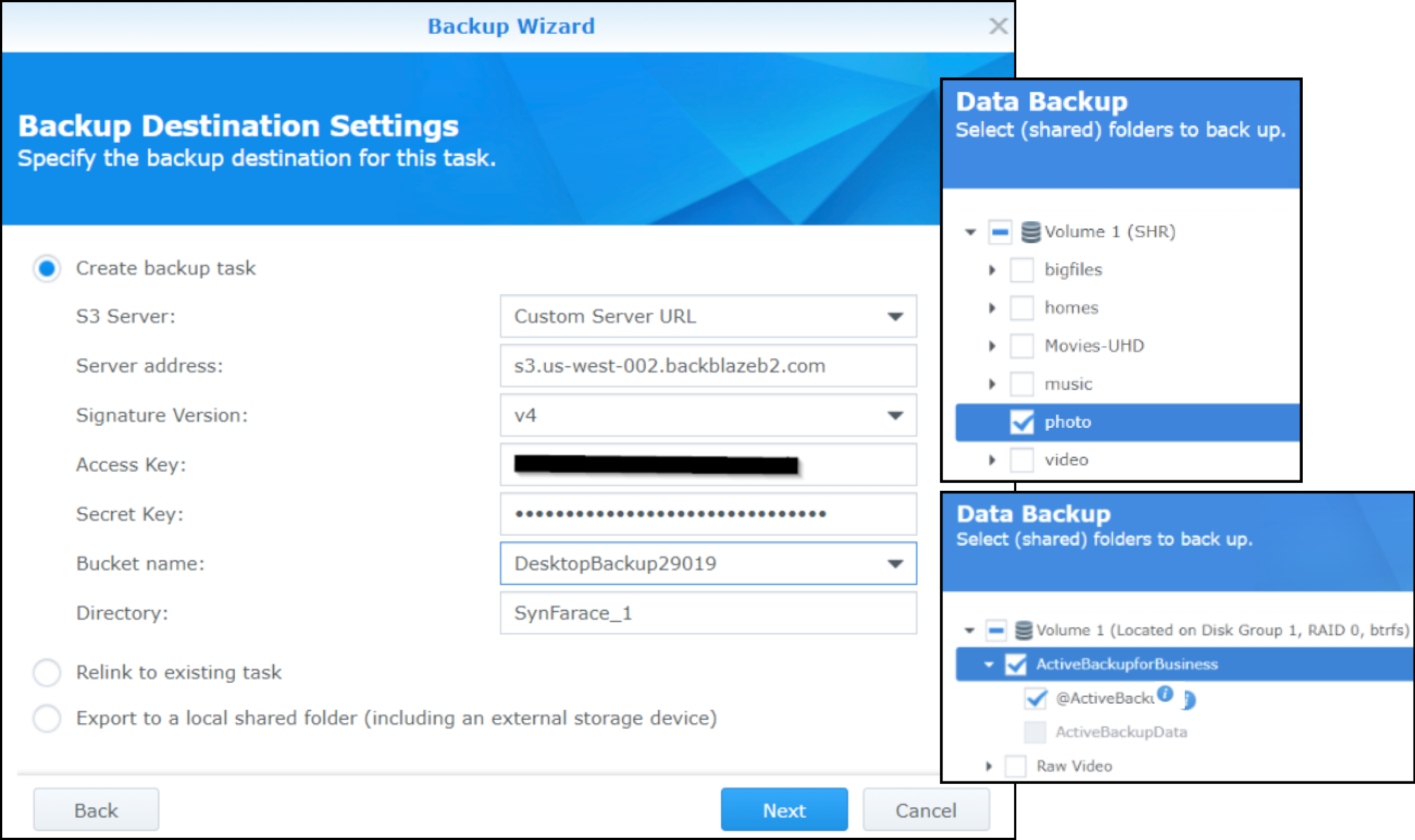- Print
- DarkLight
Synology Hyper Backup Integration with Backblaze B2
- Print
- DarkLight
Synology Hyper Backup lets you back up various kinds of data such as system configurations, shared folders, and applications or packages on your Synology network-attached storage (NAS), manually or by schedule. You can store the backup data in local shared folders, remote servers, and Backblaze B2 Cloud Storage with the S3-Compatible API.
You can copy active backup data to Backblaze B2 with Hyper Backup if you use Synology Active Backup for Business and you want to implement a 3-2-1 backup strategy.
The S3-Compatible API allows thousands of integrations to natively work with Backblaze B2. For more information about using this API, click here.
Enable Backblaze B2
Before you begin: You must have a Backblaze B2 Cloud Storage account. If you already have a Backblaze account and the left navigation menu contains a B2 Cloud Storage section, your account is already enabled for Backblaze B2.
- Sign in to the Backblaze web console.
- In the user menu in the upper-right corner of the page, select My Settings.
- Under Enabled Products, select the checkbox to enable B2 Cloud Storage.
- Review the Terms and Conditions, and click OK to accept them.
Create a Bucket
- Sign in to your Backblaze account.
- In the left navigation menu under B2 Cloud Storage, click Buckets.
- Click Create a Bucket.
- Enter a name for your bucket.
Bucket names must be at least six characters and globally unique. A message is displayed if your bucket name is already in use. - Select a privacy setting: Private or Public.
Files that are in a private bucket require authentication to perform an action, for example, downloading. Public buckets do not require authentication so you can easily share files. You can change a bucket's privacy settings at any time. - If applicable, enable a Backblaze B2 server-side encryption key.
- Click Create a Bucket, and copy the value that is in the Endpoint field; you may need this value for other processes.
- Click Lifecycle Settings to control how long to keep the files in your new bucket.
Create an Application Key
- Sign in to the Backblaze web console.
- In the left navigation menu under B2 Cloud Storage, click Application Keys.
- Click Add a New Application Key, and enter an app key name.
You cannot search an app key by this name; therefore, app key names are not required to be globally unique. Key names are limited to 100 characters and can contain letters, numbers, and "-", but not I18N characters, such as é, à, and ü. - Select All or select a specific bucket in the Allow Access to Bucket(s) menu.
- Optionally, select your access type (Read and Write, Read Only, or Write Only).
- Optionally, select Allow List All Bucket Names.
This option is required for the B2 Native API b2_list_buckets and the S3-Compatible API S3 List Buckets operations. - Optionally, enter a file name prefix to restrict application key access only to files with that prefix.
Depending on what you selected in step #4, this limits application key access to files with the specified prefix for all buckets or just the selected bucket. - Optionally, enter a positive integer to limit the time, in seconds, before the application key expires.
The value must be less than 1000 days (in seconds). - Click Create New Key, and note the resulting keyID and applicationKey values.
Configure a Synology Hyper Backup Task
You can select local directories to backup, or you can select ActiveBackupforBusiness if you use Synology Active Backup for Business and you want to implement a 3-2-1 backup strategy.
- Download Synology Hyper Backup, and open the application.
- Click +, and select Data backup task.
- Scroll down to Cloud Service, click S3 Storage, and click Next.
- Configure the backup destination settings, and click Next.
- In the S3 Server field, select Custom Server URL.
- In the Server Address field, enter your Backblaze B2 S3 endpoint.
You can find this value on the Buckets page in the Backblaze web console. - In the Signature Version field, select v4.
- In the Access Key field, enter your Backblaze B2 keyID.
- In the Secret Key field, enter your Backblaze B2 applicationKey.
- In the Bucket Name field, select the bucket that you want to use.
If you created a bucket-restricted application key, ensure that you selected the Allow List All Bucket Names option.
- Select the folders that you want to back up, and click Next.
- Select the local directories that you want to back up.
- Select ActiveBackupforBusiness if you use Synology Active Backup for Business and you want to implement a 3-2-1 backup strategy.
- Select Hyper Backup, and click Next.
- Enter a Task name (for example, Backblaze S3 Backup), click Next, and click Apply.
If you have issues using Synology Hyper Backup with Backblaze B2, email Backblaze at b2feedback@backblaze.com.

